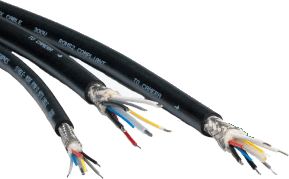Extreme Materials: Robust Performance from Cable to Connector
From specifying the correct stranding configuration to creating specialty extreme material blends to ensure optimal jacket performance, selecting the right combination of variables plays a critical role in the success of products.
 In all environments, especially extreme conditions, high reliability and zero downtime are imperative; even the smallest factor can be the difference between success and a costly failure. It is vital to consider every factor influencing performance. By conferring with subject matter experts (SME) and experienced manufacturing companies, projects and programs have the best chance of successful performance.
In all environments, especially extreme conditions, high reliability and zero downtime are imperative; even the smallest factor can be the difference between success and a costly failure. It is vital to consider every factor influencing performance. By conferring with subject matter experts (SME) and experienced manufacturing companies, projects and programs have the best chance of successful performance.
Far beyond vetting best-in-class materials, SMEs identify attributes that compliment functionality needs, anticipate environmental challenges, and adhere to budgets and schedules. By understanding the core functionality of the product and the different factors that will contribute to the attainment of each customer’s goals, the companies’ SMEs begin the critical process of requirements gathering.
Key questions to consider include:
- What is the end application of the product?
- Who are the users?
- In what environment(s) will this cable assembly need to perform?
- What element(s) will this cable assembly be exposed to (water, oil, chemicals, extreme heat, etc.)?
- What challenges could be encountered with transportation and installation?
- How will the connectivity solution be monitored and controlled?
- Will this product be subject to agency approvals or government regulations?
- What is the budget and schedule for this project?
Copper Stranding 101
Copper has been the conductor of choice for electrical wiring since the early 1800s. With a higher conductivity rating than any other non-precious metal, copper has become the standard for measuring conductive materials. Copper is also uniquely suited for use in electrical wiring due to its relatively high tensile strength, flexibility, and ductility – the pliable property of copper that allows it to be further processed without breaking or cracking. These properties, among others, make it the ideal material for wire and cable.
Why copper?
- High conductivity
- Natural flexibility
- Resists corrosion
- High tensile strength
- Dissipates heat well
- Low thermal expansion
- High ductility
- Resists deformation
- Easy to solder
Copper Coating
Bare copper is preferred in most situations, though some copper alloys are better suited in environments where excellent abrasion or corrosion resistance is needed. More commonly, copper strands have a coating applied to add the properties required for a given application.
Copper Construction and Configuration
Copper stranding is defined by both its overall size and an individual strand’s size. For example, a 0.75mm2 construction would be defined as 32 ends of 0.2mm. The 0.75mm2 would be the overall size, and then there are 32 strands of 0.2mm for each strand.
Application often determines the size of stranding that will be needed. In a power application, the ampacity requirements for the stranding will define the size needed to handle the power load, taking into account all of the conductors that are in play.
Bare copper is preferred in most situations, though some copper alloys are better suited in environments where excellent abrasion or corrosion resistance is needed. More commonly, copper strands have a coating applied to add the properties required for a given application.

Concentric
In a concentric strand, there is a solid conductor running down the center that is surrounded by layers of rotating strands. Each layer is comprised of strands running the same direction, but the direction alternates for each layer.
Unilay
The unilay configuration is similar to concentric, with layers of stranding around a center conductor. Unlike concentric, all layers rotate the same way; typically, these layers have a left-hand rotation.
Rope Lay
With the rope lay configuration, there are a number of individual bundles of stranding twisted into groups that make up one larger, solid configuration.
Stranding configuration selection depends on the end application of the cable and the environment in which the cable must perform. Key deciding factors are flex and movement requirements. The typical rule of thumb is “the more strands, the more flexible and the longer the lifespan.” From a movement and motion standpoint, a rope lay construction is by far the most flexible configuration – it is also by far the most expensive, highlighting the trade-offs buyers and engineers must constantly consider when choosing materials.
For static in-situ applications, stranding matters less. Dramatic temperature fluctuation does not affect copper as much as movement does, but it is important to consider the connection point and how the cable will be terminated, as this could be a vulnerable area.
Other factors to consider are applicable regulatory agency requirements. For example, UL requires twisted stranding in most applications. With other approvals and some agencies, manufacturers can run stranding without twisting it together.
When selecting copper stranding, ask:
- What is the primary end application and use for this cable?
- What environmental factors will this cable need to perform in successfully?
- What approvals or agency certifications are required for the application?
Strength Member Performance
Strength members add both function and protection to connectivity solutions. Specific strengthening materials may be added for unique solutions such as pull strength, push strength, mechanical strength, or rigidity. Fiberglass rods, steel strength members, and aramid fiber are three of the more common types of strength members.
Fiberglass Rods
Fiberglass rods are used when a cable has to be extremely rigid because it is being pushed through the pipe. One extreme application is for sewer system inspections where there is a camera and connector on the cable. The rod enables the cable to stand straight out. This gives the cable great compressive properties and a lot of push/pull strength.
Steel Strength Members
These steel cords are used in applications where pulling strength and compressive strength are critical. There are different types of steel strength members that may be used depending on weight requirements and durability. Stainless steel strength members provide excellent strength at just 3/16 of an inch. Galvanized steel provides pull strength of about 500 Newtons without breaking, along with superior compressive strength.
Aramid Fiber
 Aramid fiber, or Kevlar when referring to DuPont’s brand, is the extremely strong material used commonly in bulletproof vests. Ideal for extreme pulling strength in cable, aramid fiber can be stranded in a variety of configurations to achieve differing levels of strength. A bundle of four strands provides 450 – 600 Newtons of pull strength. While it is not rigid, it does offer high compressive strength without adding significant weight. If aramid fiber is used in a cable system, special attention must be given to the cable’s termination, as incorrect termination can lead to weak points in the fiber.
Aramid fiber, or Kevlar when referring to DuPont’s brand, is the extremely strong material used commonly in bulletproof vests. Ideal for extreme pulling strength in cable, aramid fiber can be stranded in a variety of configurations to achieve differing levels of strength. A bundle of four strands provides 450 – 600 Newtons of pull strength. While it is not rigid, it does offer high compressive strength without adding significant weight. If aramid fiber is used in a cable system, special attention must be given to the cable’s termination, as incorrect termination can lead to weak points in the fiber.
When selecting strength members, ask:
- What type of strength is required?
- Does this cable need to be rigid or flexible?
- What is the plan for termination and connectorization?
Cable assemblies operating in extreme settings rarely have only one environmental factor to overcome. The number of variables to take into consideration when designing connectivity solutions, along with the number of challenges these products will face, usually means that the best course of action is to work with an experienced SME.
This white paper excerpt was contributed by Northwire. To read it in its entirety, including information on multi-functional tubing, preventing leaks, fillers, barriers, shielding, and jacketing, click here.
[related_posts limit=”7″]






